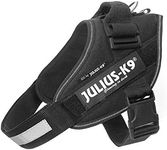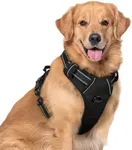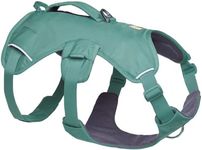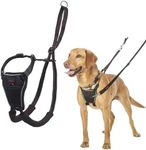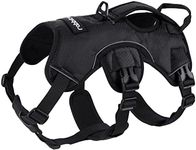Buying Guide for the Best Dog Harnesses
Choosing the right dog harness is crucial for ensuring your dog's comfort and safety during walks. A harness can provide better control over your dog, reduce strain on their neck, and help with training. When selecting a harness, consider your dog's size, behavior, and specific needs. It's important to measure your dog accurately and understand the different features available to make an informed decision.Size and FitSize and fit are critical when selecting a dog harness. A harness that is too tight can cause discomfort or even injury, while one that is too loose may allow your dog to slip out. To find the right size, measure your dog's chest and neck, and refer to the manufacturer's sizing chart. Harnesses often come in small, medium, large, and extra-large sizes. Choose a size that allows for a snug fit but leaves enough room for two fingers to fit between the harness and your dog's body. Consider your dog's breed and body shape, as some harnesses are designed specifically for certain types of dogs.
MaterialThe material of a dog harness affects its durability, comfort, and ease of cleaning. Common materials include nylon, polyester, and leather. Nylon and polyester are lightweight, durable, and easy to clean, making them suitable for everyday use. Leather is more durable and can be more comfortable for some dogs, but it requires more maintenance. If your dog has sensitive skin, look for harnesses with padded or breathable materials to prevent irritation. Consider your dog's activity level and the weather conditions in your area when choosing the material.
Type of HarnessThere are several types of dog harnesses, each designed for different purposes. Back-clip harnesses have a leash attachment on the back and are suitable for well-behaved dogs who don't pull. Front-clip harnesses have a leash attachment on the chest and can help discourage pulling by redirecting the dog's attention. Dual-clip harnesses offer both front and back attachments for versatility. Step-in harnesses are easy to put on and take off, making them ideal for dogs who dislike having things put over their heads. Choose a type based on your dog's behavior and your training goals.
AdjustabilityAdjustability is important to ensure a proper fit as your dog grows or changes weight. Look for harnesses with multiple adjustment points, such as around the neck, chest, and belly. This allows you to customize the fit to your dog's unique shape and size. Adjustable harnesses are especially useful for puppies who are still growing or for dogs who may gain or lose weight. Ensure that the harness is easy to adjust and stays securely in place once fitted.
Safety FeaturesSafety features in a dog harness can provide additional security and peace of mind. Reflective strips or stitching enhance visibility during low-light conditions, making it safer for evening or early morning walks. Some harnesses come with a handle on the back, which can be useful for helping your dog over obstacles or for extra control in crowded areas. Consider your dog's behavior and your walking environment when evaluating safety features. If you often walk in busy or dimly lit areas, prioritize harnesses with reflective elements.
